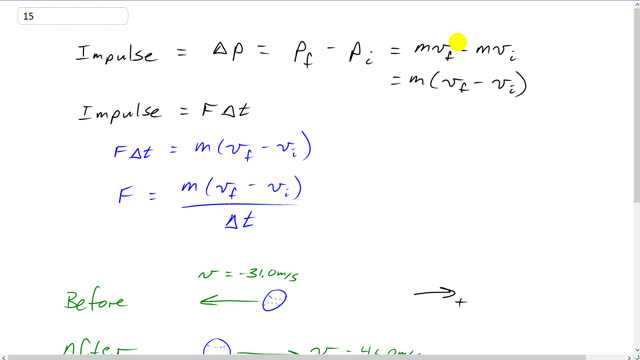
A 0.145-kg baseball pitched at 31.0 m/s is hit on a horizontal line drive straight back at the pitcher at 46.0 m/s. If the contact time between bat and ball is , calculate the force (assumed to be constant) between the ball and bat.

In order to watch this solution you need to have a subscription.
This is Giancoli Answers with Mr. Dychko. Impulse is change in momentum so that's final momentum minus initial momentum which is the mass times the final velocity minus mass times initial velocity and the mass of the ball doesn't change so we can factor it out— it's a common factor— and so we have m times v f minus v i— that's the impulse. Now impulse when you have a constant force, which we assume in this question, is also equal to F times the time during which the force is applied so FΔt. And so if impulse equals this and impulse equals that that means these two things are equal to each other which is what I'm saying here. So force times time equals mass times the change in velocity and then divide both sides by time to solve for the force. So here's our formula that we are gonna plug in numbers. And the one thing to watch out for in this question is your negative signs for the velocity. So we'll say to the right is positive in which case, the initial velocity of this baseball as I have drawn here, it's to the left so it's negative 31 meters per second and the pitcher must be over here somewhere— the guy who threw the ball— and then after it connects with the baseball bat, it's directed back towards the pitcher with a velocity of positive 46 meters per second. So we substitute those velocities into our force formula here and we put those numbers here and we end up with the force is 0.145 kilograms—mass of the ball— times a final velocity of 46.0 meters per second positive minus—from the formula—negative 31.0 meters per second, initial velocity, and divide by 5 milliseconds and you end up with 2230 newtons with three significant figures and you can elaborate by saying that is towards the pitcher but just writing a positive number there I think is enough because I have already defined the coordinate system in the picture here.